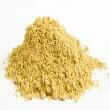Background
- Asafoetida, or asafetida (Ferula assafoetida), is a plant native to Iran that has a strong sulfurous smell. The sap of the stem and roots is dried and crushed to form an onion-tasting powder that is frequently used in Indian and Middle Eastern cuisine. Jains (followers of the Jain religion, an ancient faith based on the teachings of the prince Mahavira, 599 - 527 BC) also use it as a substitute for onions.
- There is currently little information available on the pharmacology and medicinal uses of asafoetida. Limited animal research suggests that asafetida may increase the calcium and zinc content in bone after exposure to radiation. However, there is currently insufficient evidence in humans to support the use of asafoetida for any indication.
References
Natural Standard developed the above evidence-based information based on a thorough systematic review of the available scientific articles. For comprehensive information about alternative and complementary therapies on the professional level, go to . Selected references are listed below.
- Abd El-Razek, MH, Ohta, S, Ahmed, AA, et al. Sesquiterpene coumarins from the roots of Ferula assa-foetida. Phytochemistry 2001;58(8):1289-1295.
View Abstract - Appendino, G, Maxia, L, Bascope, M, et al. A meroterpenoid NF-kappaB inhibitor and drimane sesquiterpenoids from Asafetida. J Nat Prod 2006;69(7):1101-1104.
View Abstract - Carrubba, RW. The first report of the harvesting of Asafetida in Iran. Agric Hist 1979;53(2):451-461.
View Abstract - Duan, H, Takaishi, Y, Tori, M, et al. Polysulfide derivatives from Ferula foetida. J Nat Prod 2002;65(11):1667-1669.
View Abstract - Fatehi, M, Farifteh, F, and Fatehi-Hassanabad, Z. Antispasmodic and hypotensive effects of Ferula asafoetida gum extract. J Ethnopharmacol 2004;91(2-3):321-324.
View Abstract - Harve, G and Kamath, V. Larvicidal activity of plant extracts used alone and in combination with known synthetic larvicidal agents against Aedes aegypti. Indian J Exp Biol 2004;42(12):1216-1219.
View Abstract - Ren, D, Yang, W, and Zeng, G. [Effects of microwave radiation on the content of five elements in mice bone tissue]. Wei Sheng Yan.Jiu 2001;30(4):201-202.
View Abstract - Singh, UP, Singh, DP, Maurya, S, et al. Investigation on the phenolics of some spices having pharmacotherapeuthic properties. J Herb Pharmacother 2004;4(4):27-42.
View Abstract - Uma, Pradeep K, Geervani, P, et al. Common Indian spices: nutrient composition, consumption and contribution to dietary value. Plant Foods Hum Nutr 1993;44(2):137-148.
View Abstract - Unnikrishnan, MC and Kuttan, R. Cytotoxicity of extracts of spices to cultured cells. Nutr Cancer 1988;11(4):251-257.
View Abstract







